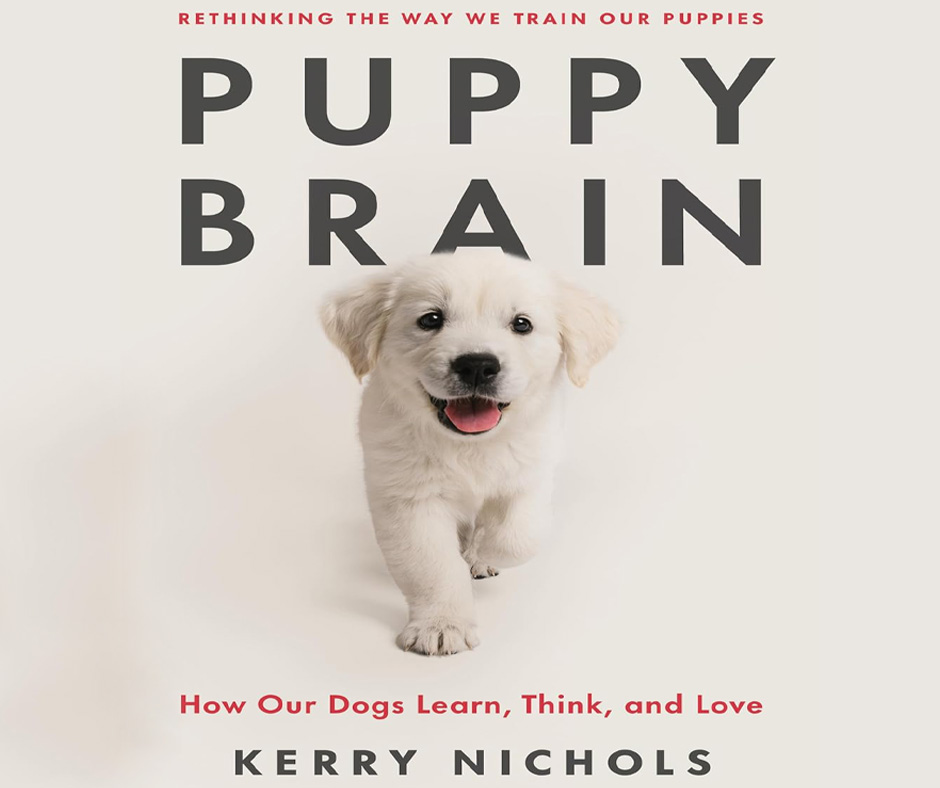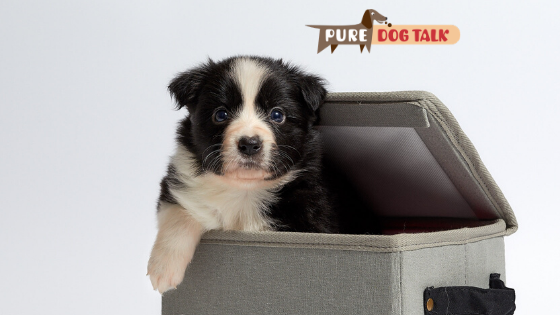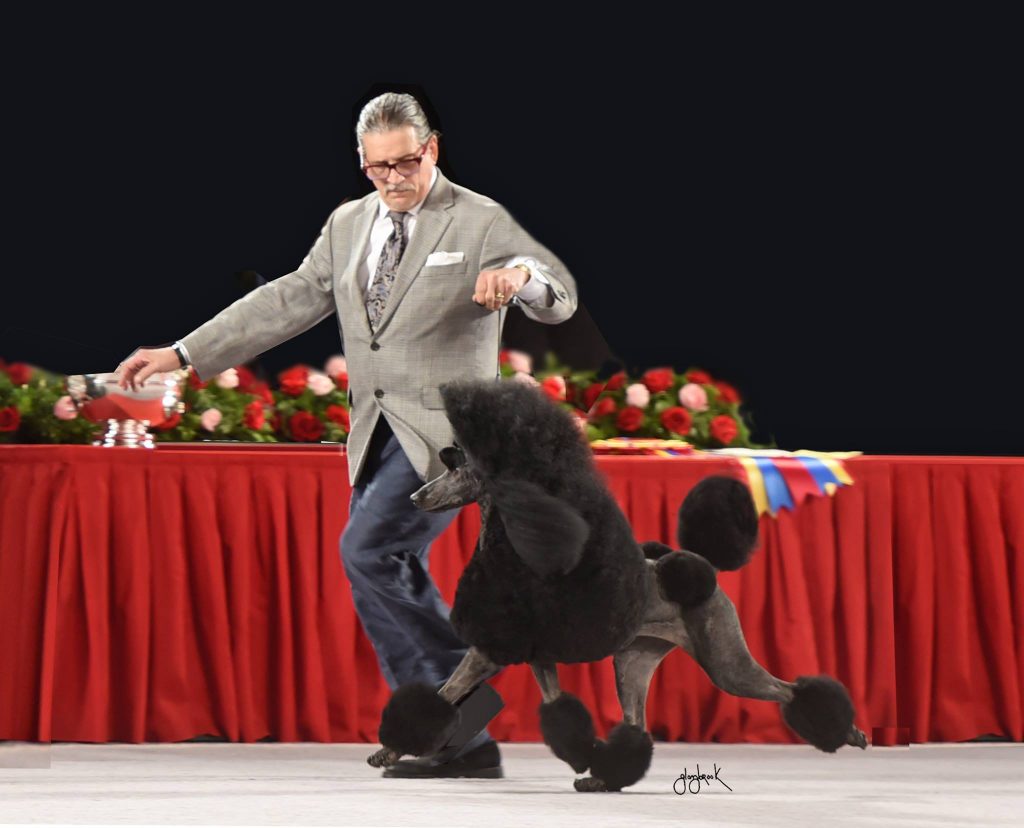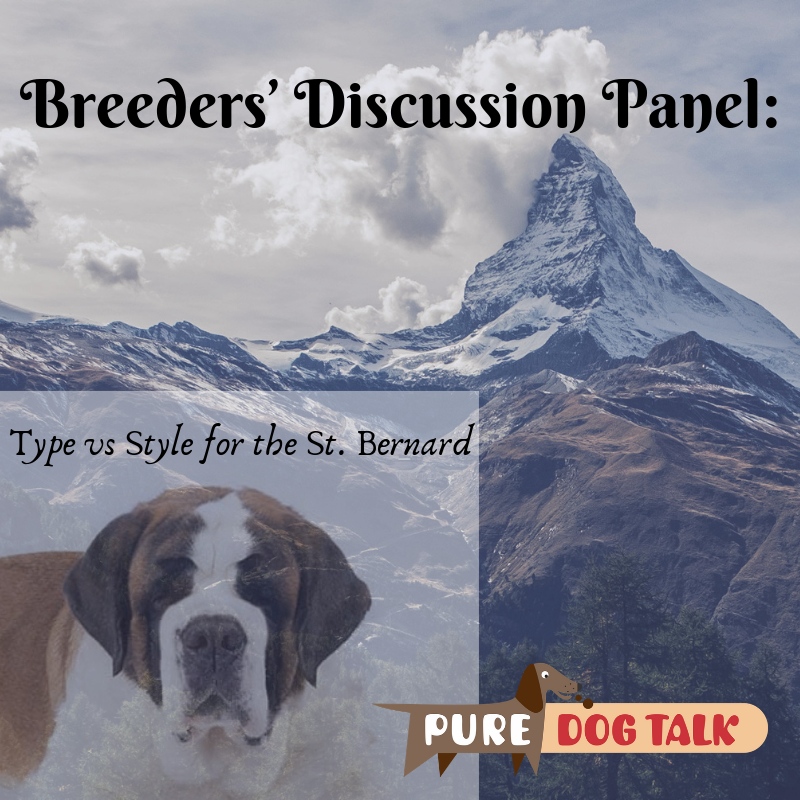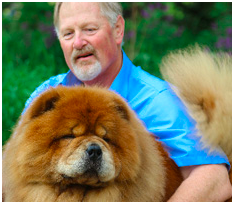639 – Puppy Brain: How Our Dogs Learn, Think and Love
Puppy Brain: How Our Dogs Learn, Think and Love
Author Kerry Nichols joins host Laura Reeves for a review of her new book, “Puppy Brain: How Our Dogs Learn, Think and Love.”
Nichols’ book is written for the dog buying public to help them understand how to find a breeder, what a responsible breeder looks like, how puppies learn, and how breeders and buyers can work together to raise well-adjusted dogs.
“We all know you have to prepare your families,” Nichols said. “Like the more prepared your families are the better your puppies’ lives will be. So from litter number one, I started to joke around ‘hey, you know you’re enrolling in Nicholberry boot camp. If you’re not ready to read and watch and listen I’m not the breeder for you, because I really want you to be ready.
“That actually evolved into requiring that our families take a training course, you know, I really want them to be prepared because we’ve all seen it go badly when they’re not and you send home this lovely puppy who very quickly gets into trouble and that’s heart -wrenching to see.
“I had this whole backlog of a private blog that I was keeping for our families and basically they needed to read a pretty hefty article or watch a video every day for the eight weeks that their puppy was growing.”
As a content creator, Nichols has proven suggestions for breeders also about how to grow their educational social media outreach about their breed and their breeding programs.
- It’s a marathon not a sprint … don’t think that you’re going to post 10, 50, 100 posts and you’re going to get this following. It is consistency, consistency, consistency.
- Authenticity, which is why I think it doesn’t work to hire a social media manager.I’ve had arguments with people on this topic, but there’s no way I could have never hired anybody to do what I do because, it’s all in my DMs. I’m responding, it’s in my comments, I’m interacting. And that’s fantastic because the questions will inform your content.
- I think it’s super important that breeders allow people to see what they’re actually doing on a daily basis.Yesterday, someone asked me to vet a breeder for them of a different breed, and I went on the website and it said that they followed puppy culture protocols. And they have a big following on Instagram, but I couldn’t find a single video that demonstrated puppy culture protocols.So that’s fine to say it, but I don’t just trust that they’re doing it. I want to see them doing a barrier challenge, right? So I’d say that, show what you’re actually doing.
375 – Dog Breeding: We’re ALL in this Together
Dog Breeding: We’re ALL in this Together
Patti Strand, the founder of the National Animal Interest Alliance, joins host Laura Reeves to talk about all dog breeders working together, raising the bar for the health and well-being of all dogs.
Strand provides an outstanding historical perspective on the question of dog breeding throughout the 20th century, commercial breeding operations to meet community demand for companion dogs, the programs put in place to monitor breeders and the confusion of outdated information.
“…there is a passion among commercial breeders today to do a better job and to learn how to do a better job,” Strand said. “One of our (NAIA) board members, Marty Greer, is a veterinarian. She gives a lot of seminars, a lot of health seminars … veterinary care-type seminars in the commercial dog breeding world. And she says she never had a more attentive audience. These people are taking notes and they’re asking questions. They’re excited about breeding. They’re excited about husbandry. So just a ton of really positive changes have taken place.”
Strand, a Dalmatian breeder for decades, added, “I’m a hobby breeder. I love what I do. I try to do it well. But what I’m really working toward is trying to support people who try to conduct themselves in the best way possible with the information and education and materials that we have.”
As president of NAIA, Strand works on legislation that impacts all breeders. Including researching actual numbers of dogs in animal shelters around the US.
“I had this experience last year in working on some legislation,” Strand commented. “I had a situation where a woman who owned a pet store asked me to help her and she told me that she was doing everything right.
“(I told her) ‘if you can demonstrate to me what you’re doing and you have a solid operation I will try to help you.’ So next morning I get up and I have like 150 documents from this woman. Every single puppy she bought from somebody whose USDA inspection reports were excellent. And not only that, every single puppy she bought had parents who were health tested for the very things that the hobby dog breeder world requires when you go to our AKC parent websites. The Breeders that were working with this particular distributor were all going to the AKC and the parent club websites and finding out what the requirements were for their breed and then duplicating it. So believe me, even 5 years ago you would not have seen that,” Strand observed.
“I think the reality is that we would all want pet stores or breeders, whether they’re hobby or commercial, who are doing things badly and where animals are being harmed not to be able to operate. I mean it’s just that simple. So with us at NAIA, we’re just all about conduct rather than categorizing people by putting a particular marketing label on people and then saying this label is no good and that label is good.”
362 — Joseph Vergnetti: the Art and Science of Dog Breeding
Joseph Vergnetti: the Art and Science of Dog Breeding
“Breeding is Like a Recipe, You Need All the Ingredients On Hand”
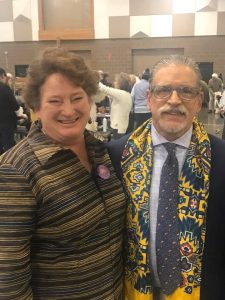
Host Laura Reeves and Joseph Vergnetti in Puyallup, Washington.
So says Joseph Vergnetti, master breeder at Dassin Poodles. Vergnetti talks about the presentation, line-breeding and outcrosses, and the differences in the varieties.
In partnership with Ellen Charles, Vergnetti has been voted Breeder of the Year twice by his peers and was selected Non-Sporting breeder of the year by the American Kennel Club. They have produced more than 300 champions across all varieties of poodles.
Starting Young
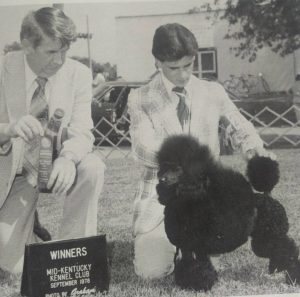 Starting with a toy poodle that he learned to trim by himself at 10 years old, Vergnetti has successfully bred Boxers, Great Danes and American Foxhounds as well. He apprenticed with professional handlers in his teens, including Ted Young Jr, then went to work for Wendell Sammet, Ale Kai poodles.
Starting with a toy poodle that he learned to trim by himself at 10 years old, Vergnetti has successfully bred Boxers, Great Danes and American Foxhounds as well. He apprenticed with professional handlers in his teens, including Ted Young Jr, then went to work for Wendell Sammet, Ale Kai poodles.
“Wendell was hardest worker in the world. Everything was very precise,” Vergnetti said.
It was during this late ‘60s, early ‘70s time frame, that the trimming and presentation style of poodles changed dramatically, Vergnetti said, with the “spray up” becoming more and more important.
“Today it is a little over-done,” Vergnetti said. “They are almost a caricature, way over the top. Hairspray and excessive presentation has taken over. In a way, I think poodles are a victim of their own beauty. There is a normal dog (construction) under all the hair. That’s very important.”
Differences in varieties
Miniature poodles are Vergnetti’s favorite, he said, adding that “Miniatures are smart. They’re the perfect size. They know what they like and what they don’t.” He noted that miniatures often have more work ethic than standards. They were originally truffle dogs and circus dogs. “They don’t take much (grief) from anybody.”
Breeding planning
When breeding dogs, you need to have all ingredients, like a recipe, Vergnetti opined. The Dassin program generally maintains seven or eight stud dogs and an average of 10 bitches… “It’s important to have the dogs you want in front of you,” he said.
The Dassin Farms facility features a four-story-tall barn for a kennel building, Vergnetti said, with 50-60 runs and 72 windows all around.
“We can see the dogs all day, every single day. We take hair off the puppies to see the bodies. You can see temperament. We evaluate them every day on their own,” Vergnetti said, which he adds is how they make decisions about which dogs to keep.
285 – Type vs Style in the St. Bernard: Breeders’ Discussion Panel
Type vs Style in the Saint Bernard: Breeders’ Discussion Panel
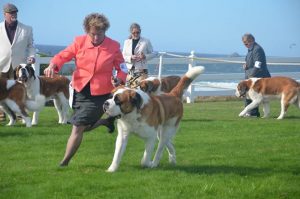 Host Laura Reeves moderated a Breeders’ Discussion Panel at the 2018 Saint Bernard Club of America National Specialty. Three long-time breeders talk type versus style in this fascinating conversation.
Host Laura Reeves moderated a Breeders’ Discussion Panel at the 2018 Saint Bernard Club of America National Specialty. Three long-time breeders talk type versus style in this fascinating conversation.
Type defines a breed. Style informs the breeders’ understanding of the standard. A conversation with successful breeders provides information that’s applicable across all breeds.
From descriptions of developing a breeding program that establishes a recognizable style, to addressing specific pieces of the standard, this wide-ranging conversation is inspiring, enlightening and entertaining.
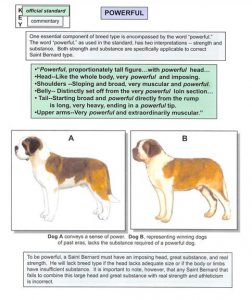
The standard defines the Saint Bernard as “proportionally tall and powerful”. What does that mean to the breeders?
Interpreting the standard from three different perspectives provides unending opportunities for learning. For example, the Saint Bernard standard has no description of correct movement or gait. By understanding the breed history, these breeders apply function to form to answer the question.
Listen to the Pure Dog Talk interview with breeder judge Joan Zelinski for more in-depth conversation about the breed.
The breed standard is included below for listeners to follow along.
Official Standard of the Saint Bernard
Shorthaired
General Appearance: Powerful, proportionately tall figure, strong and muscular in every part, with powerful head and most intelligent expression. In dogs with a dark mask the expression appears more stern, but never ill-natured.
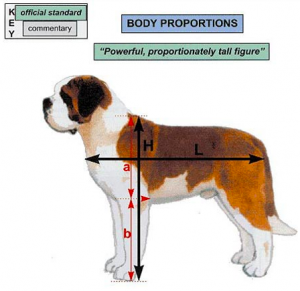 Head: Like the whole body, very powerful and imposing. The massive skull is wide, slightly arched and the sides slope in a gentle curve into the very strongly developed, high cheek bones. Occiput only moderately developed. The supra-orbital ridge is very strongly developed and forms nearly a right angle with the long axis of the head. Deeply imbedded between the eyes and starting at the root of the muzzle, a furrow runs over the whole skull. It is strongly marked in the first half, gradually disappearing toward the base of the occiput. The lines at the sides of the head diverge considerably from the outer corner of the eyes toward the back of the head. The skin of the forehead, above the eyes, forms rather noticeable wrinkles, more or less pronounced, which converge toward the furrow. Especially when the dog is alert or at attention the wrinkles are more visible without in the least giving the impression of morosity. Too strongly developed wrinkles are not desired. The slope from the skull to the muzzle is sudden and rather steep. The muzzle is short, does not taper, and the vertical depth at the root of the muzzle must be greater than the length of the muzzle. The bridge of the muzzle is not arched, but straight; in some dogs, occasionally, slightly broken. A rather wide, well-marked, shallow furrow runs from the root of the muzzle over the entire bridge of the muzzle to the nose. The flews of the upper jaw are strongly developed, not sharply cut, but turning in a beautiful curve into the lower edge, and slightly overhanging. The flews of the lower jaw must not be deeply pendant. The teeth should be sound and strong and should meet in either a scissors or an even bite; the scissors bite being preferable. The undershot bite, although sometimes found with good specimens, is not desirable. The overshot bite is a fault. A black roof to the mouth is desirable. Nose (Schwamm) – Very substantial, broad, with wide open nostrils, and, like the lips, always black.
Head: Like the whole body, very powerful and imposing. The massive skull is wide, slightly arched and the sides slope in a gentle curve into the very strongly developed, high cheek bones. Occiput only moderately developed. The supra-orbital ridge is very strongly developed and forms nearly a right angle with the long axis of the head. Deeply imbedded between the eyes and starting at the root of the muzzle, a furrow runs over the whole skull. It is strongly marked in the first half, gradually disappearing toward the base of the occiput. The lines at the sides of the head diverge considerably from the outer corner of the eyes toward the back of the head. The skin of the forehead, above the eyes, forms rather noticeable wrinkles, more or less pronounced, which converge toward the furrow. Especially when the dog is alert or at attention the wrinkles are more visible without in the least giving the impression of morosity. Too strongly developed wrinkles are not desired. The slope from the skull to the muzzle is sudden and rather steep. The muzzle is short, does not taper, and the vertical depth at the root of the muzzle must be greater than the length of the muzzle. The bridge of the muzzle is not arched, but straight; in some dogs, occasionally, slightly broken. A rather wide, well-marked, shallow furrow runs from the root of the muzzle over the entire bridge of the muzzle to the nose. The flews of the upper jaw are strongly developed, not sharply cut, but turning in a beautiful curve into the lower edge, and slightly overhanging. The flews of the lower jaw must not be deeply pendant. The teeth should be sound and strong and should meet in either a scissors or an even bite; the scissors bite being preferable. The undershot bite, although sometimes found with good specimens, is not desirable. The overshot bite is a fault. A black roof to the mouth is desirable. Nose (Schwamm) – Very substantial, broad, with wide open nostrils, and, like the lips, always black.
Ears – Of medium size, rather high set, with very strongly developed burr (Muschel) at the base. They stand slightly away from the head at the base, then drop with a sharp bend to the side and cling to the head without a turn. The flap is tender and forms a rounded triangle, slightly elongated toward the point, the front edge lying firmly to the head, whereas the back edge may stand somewhat away from the head, especially when the dog is at attention. Lightly set ears, which at the base immediately cling to the head, give it an oval and too little marked exterior, whereas a strongly developed base gives the skull a squarer, broader and much more expressive appearance.
Eyes – Set more to the front than the sides, are of medium size, dark brown, with intelligent, friendly expression, set moderately deep. The lower eyelids, as a rule, do not close completely and, if that is the case, form an angular wrinkle toward the inner corner of the eye. Eyelids which are too deeply pendant and show conspicuously the lachrymal glands, or a very red, thick haw, and eyes that are too light, are objectionable.
Neck: Set high, very strong and when alert or at attention is carried erect. Otherwise horizontally or slightly downward. The junction of head and neck is distinctly marked by an indentation. The nape of the neck is very muscular and rounded at the sides which makes the neck appear rather short. The dewlap of throat and neck is well pronounced: too strong development, however, is not desirable.
Shoulders: Sloping and broad, very muscular and powerful. The withers are strongly pronounced.
Chest: Very well arched, moderately deep, not reaching below the elbows.
Back: Very broad, perfectly straight as far as the haunches, from there gently sloping to the rump, and merging imperceptibly into the root of the tail.
Hindquarters: Well-developed. Legs very muscular.
Belly: Distinctly set off from the very powerful loin section, only little drawn up.
Tail: Starting broad and powerful directly from the rump is long, very heavy, ending in a powerful tip. In repose it hangs straight down, turning gently upward in the lower third only, which is not considered a fault. In a great many specimens the tail is carried with the end slightly bent and therefore hangs down in the shape of an “f”. In action all dogs carry the tail more or less turned upward. However it may not be carried too erect or by any means rolled over the back. A slight curling of the tip is sooner admissible.
Upper Arms: Very powerful and extraordinarily muscular.
Lower Leg: Straight, strong.
Hind legs: Hocks of moderate angulation. Dewclaws are not desired; if present, they must not obstruct gait.
Feet: Broad, with strong toes, moderately closed, and with rather high knuckles. The so-called dewclaws which sometimes occur on the inside of the hind legs are imperfectly developed toes. They are of no use to the dog and are not taken into consideration in judging. They may be removed by surgery.
Coat: Very dense, short-haired (stockhaarig), lying smooth, tough, without however feeling rough to the touch. The thighs are slightly bushy. The tail at the root has longer and denser hair which gradually becomes shorter toward the tip. The tail appears bushy, not forming a flag.
Color: White with red or red with white, the red in its various shades; brindle patches with white markings. The colors red and brown-yellow are of entirely equal value. Necessary markings are: white chest, feet and tip of tail, noseband, collar or spot on the nape; the latter and blaze are very desirable. Never of one color or without white. Faulty are all other colors, except the favorite dark shadings on the head (mask) and ears. One distinguishes between mantle dogs and splashcoated dogs.
Height at Shoulder: Of the dog should be 27½ inches minimum, of the bitch 25½ inches. Female animals are of finer and more delicate build.
Considered as Faults: Are all deviations from the Standard, as for instance a swayback and a disproportionately long back, hocks too much bent, straight hindquarters, upward growing hair in spaces between the toes, out at elbows, cowhocks and weak pasterns.
Longhaired: The longhaired type completely resembles the shorthaired type except for the coat which is not shorthaired (stockhaarig) but of medium length plain to slightly wavy, never rolled or curly and not shaggy either. Usually, on the back, especially from the region of the haunches to the rump, the hair is more wavy, a condition, by the way, that is slightly indicated in the shorthaired dogs. The tail is bushy with dense hair of moderate length. Rolled or curly hair, or a flag tail, is faulty. Face and ears are covered with short and soft hair; longer hair at the base of the ear is permissible. Forelegs only slightly feathered; thighs very bushy.
173 – Dreamland Chow Chows “Show Ring is Mirror of the Whelping Box”
Chow Chow Breeder/Handler Shares His Story
Michael & Linda Brantley were AKC’s Non-Sporting Breeders of The Year in 2013 for their Dreamland Chow Chows. Michael is a professional handler, member of the Professional Handlers Association, and has shown top ranked, multiple Best in Show winners in numerous breeds.
Breeding is the Art
“Still, the breeding is very important to me,” Brantley said, “probably more so than the handling. The handling is more the game, but the breeding is the art.”
While Michael says he’s never actually counted, Dreamland Chow Chows have produced more than 200 champions in last 40-plus years.
Brantley’s folks started in Pekingese and were breeding and showing them when he was born. His family acquired their first Chow Chow when Michael was in grade school and never looked back.
The first time Brantley was paid to show a dog, he was thrilled to realize he could “support his habit” with handling.
“I’ve been handling full-time for 40 something years,” Brantley said. “So that ended up (going) from a hobby to a career.”
To this day, handling and breeding, for Brantley, work hand in glove.
“ I think the handling of the other breeds has really helped me understand my breed better,” Brantley said. “It helped me understand structure and function tremendously. More than if I had just stuck with my breed and not sat around and watched these other dogs show or learn the standards of them before I showed the dogs. So, it’s been a double edged thing there where it’s taught me a lot.”
But the hobby, the breeding piece, remains the most compelling for Brantley.
“The show ring is just a mirror of the whelping box,” Brantley observed.
“… maybe 20-25 percent of the dogs that we breed will end up in the show ring,” he added. “Maybe. So, the rest of those dogs are going to go as companions to people. And in a breed that is very strong willed, very independent like Chow’s are, like our Tibetan Mastiffs are as well, it’s extremely important to have that proper temperament to where they end up as being great pets for somebody.
“They think for themselves. They’re happy you’re there, but they would rather go out by themselves. So, you’ve got to learn how to deal with that and it’s not something you learn overnight and it’s something that you’ve got to figure out.”
I hope you enjoy this great Talk with a man who brings a wealth of knowledge and wisdom.
And don’t forget to stick around for Allison Foley’s Tip of the Week on how to manage the male dog’s performance when bitches in season are in the ring.

